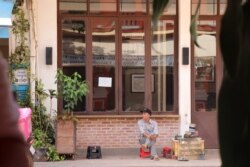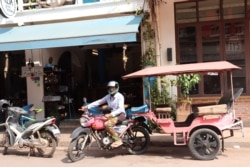The popular “Pub Street” sign in the temple town of Siem Reap shines bright against the night sky. But, nearly all the bars, restaurants, and clubs lining the usually-crowded tourist trap are dark and silent.
Before the novel coronavirus pandemic, massage parlor staffers would try their best to entice tourists to sample the various types of Khmer massages and tuk tuk drivers could be seen animatedly directing travelers to jump into their vehicles. Nowadays, there is an eerie silence resonating through the temple town.
For the last two months, Cambodia’s most popular tourist destination, and home to the Angkor Archaeological Park, has felt the effects of the viral outbreak that has decimated the global travel industry.
Siem Reap’s 130,000 residents are reliant on the tourism business, with the town’s streets normally teeming with tourists, vendors, residents, and a melee of vehicles are deserted.
On one such street, Im Srey Mom sat idly at Phsar Chas restaurant scanning the area for potential diners. The empty tables and chairs are indicative of the hardships facing the service sector, especially family-run, and small businesses.
“These are no tourists. These are only local people,” she said, pointing to the smattering of pedestrians walking around. This has been her daily activity for the past few weeks.
After a local man tested positive in the province in early March, Im Srey Mom closed her restaurant for six weeks, only to reopen this month. She has to earn around $300 a month to pay for overheads, which included electricity costs and rent.
But, the lull in tourist arrivals has hit her revenues hard, causing her to temporarily fire five staff members. Even the vendors outside her restaurant had disappeared. “They all have gone home,” she said.
News from the Tourism Ministry was not encouraging, providing little solace for the town’s residents. Kong Sophearak, at the Tourism Ministry’s Statistics Department, said tourist arrivals at the Siem Reap International Airport had dropped nearly 60 percent since the start of the outbreak.
“The number had dropped in January and February but it was not a sharp drop,” he said. “The number from April has plummeted even more.”
The Tourism Ministry official had little advice for struggling businesses except to recommend they remain safe during the pandemic.
“For food vendors, they could provide take away or organize tables to be far from each other,” he said. “And for hospitality and transportation [businesses] we have to follow hygiene guidelines too.”
Not far from the Phsar Chas restaurant, Im Bunlo was standing near his tuk tuk. The 38-year-old was in a similar position to Im Srey Mom; he owned a restaurant, there was a precipitous drop in customers and staff members were let go.
“I had a restaurant for around four months before the COVID-19 [outbreak],” Im Bunlo said. “When the coronavirus arrived, I went bankrupt.”
After shuttering the restaurant, he decided to take up the equally precarious job of ferrying people around the town in a tuk tuk. So far, he has had only a few local passengers.
“Now I drive a tuk tuk instead. I mostly drive Cambodian customers.”
At the town’s markets, souvenir vendors were facing similar challenges. The lack of tourists meant they too were struggling to provide for their families.
Cha Rady was seated at her mother’s souvenir store at the popular and tourist-friendly Phsar Chas market, also known as Old Market. In the absence of any customers, the Siem Reap resident seems to keep busy by arranging and then re-arranging her offerings, which include bags, scarves, and Cambodia-themed clothing.
Before the pandemic, the mother-daughter duo was able to earn at least $100 a day selling curios, trinkets, and souvenirs to tourists. Now, on a lucky day, they earn at best $10 a day. “Sometimes no one buys a single thing,” she said.
Back at Pub Street, Long Vichet spends most of his days surfing the internet on his smartphone. The tuk tuk driver had not a single customer that day.
“Some days I get nothing. I just sit and browse the internet,” he said. “Today, I have not gotten a single riel.”
After a decade of riding a tuk tuk, Long Vichet is now able to earn a maximum of $5 a day. The 32-year-old man is having a tough time dealing with the economic slowdown and is impatiently waiting for the return of domestic and international tourists.
“I want tourists to come back to Siem Reap,” he said.







